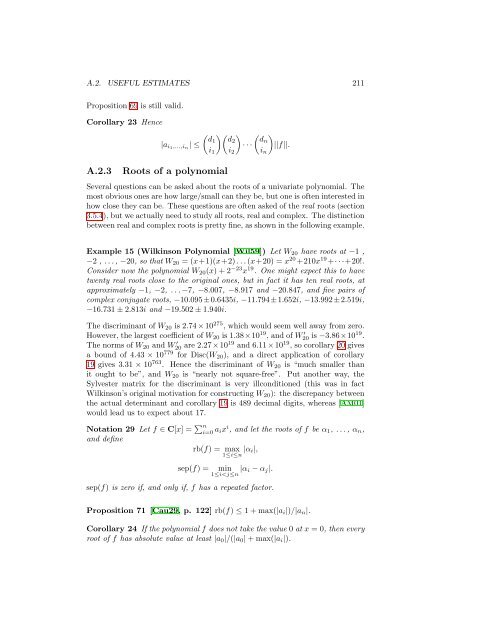Contents - Student subdomain for University of Bath
Contents - Student subdomain for University of Bath
Contents - Student subdomain for University of Bath
You also want an ePaper? Increase the reach of your titles
YUMPU automatically turns print PDFs into web optimized ePapers that Google loves.
A.2. USEFUL ESTIMATES 211<br />
Proposition 69 is still valid.<br />
Corollary 23 Hence<br />
A.2.3<br />
|a i1,...,i n<br />
| ≤<br />
Roots <strong>of</strong> a polynomial<br />
( )( ) ( )<br />
d1 d2 dn<br />
· · · ||f||.<br />
i 1 i 2 i n<br />
Several questions can be asked about the roots <strong>of</strong> a univariate polynomial. The<br />
most obvious ones are how large/small can they be, but one is <strong>of</strong>ten interested in<br />
how close they can be. These questions are <strong>of</strong>ten asked <strong>of</strong> the real roots (section<br />
3.5.4), but we actually need to study all roots, real and complex. The distinction<br />
between real and complex roots is pretty fine, as shown in the following example.<br />
Example 15 (Wilkinson Polynomial [Wil59]) Let W 20 have roots at −1 ,<br />
−2 , . . . , −20, so that W 20 = (x+1)(x+2) . . . (x+20) = x 20 +210x 19 +· · ·+20!.<br />
Consider now the polynomial W 20 (x) + 2 −23 x 19 . One might expect this to have<br />
twenty real roots close to the original ones, but in fact it has ten real roots, at<br />
approximately −1, −2, . . . −7, −8.007, −8.917 and −20.847, and five pairs <strong>of</strong><br />
complex conjugate roots, −10.095±0.6435i, −11.794±1.652i, −13.992±2.519i,<br />
−16.731 ± 2.813i and −19.502 ± 1.940i.<br />
The discriminant <strong>of</strong> W 20 is 2.74 × 10 275 , which would seem well away from zero.<br />
However, the largest coefficient <strong>of</strong> W 20 is 1.38×10 19 , and <strong>of</strong> W 20 ′ is −3.86×10 19 .<br />
The norms <strong>of</strong> W 20 and W 20 ′ are 2.27 × 10 19 and 6.11 × 10 19 , so corollary 20 gives<br />
a bound <strong>of</strong> 4.43 × 10 779 <strong>for</strong> Disc(W 20 ), and a direct application <strong>of</strong> corollary<br />
19 gives 3.31 × 10 763 . Hence the discriminant <strong>of</strong> W 20 is “much smaller than<br />
it ought to be”, and W 20 is “nearly not square-free”. Put another way, the<br />
Sylvester matrix <strong>for</strong> the discriminant is very illconditioned (this was in fact<br />
Wilkinson’s original motivation <strong>for</strong> constructing W 20 ): the discrepancy between<br />
the actual determinant and corollary 19 is 489 decimal digits, whereas [AM01]<br />
would lead us to expect about 17.<br />
Notation 29 Let f ∈ C[x] = ∑ n<br />
i=0 a ix i , and let the roots <strong>of</strong> f be α 1 , . . . , α n ,<br />
and define<br />
rb(f) = max<br />
1≤i≤n |α i|,<br />
sep(f) =<br />
min |α i − α j |.<br />
1≤i












![[Luyben] Process Mod.. - Student subdomain for University of Bath](https://img.yumpu.com/26471077/1/171x260/luyben-process-mod-student-subdomain-for-university-of-bath.jpg?quality=85)



